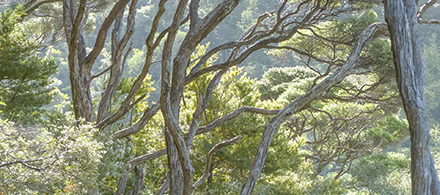Planting New Zealand’s most flammable native trees in a pocket of ancient forest damaged by wildfire may not seem the most obvious way to regenerate the land. But the New Zealand Department of Conservation (DOC) hopes introducing mānuka and kānuka in a scenic reserve near Nelson will help speed up the regeneration of parts of a beech-podocarp forest damaged by one of the country’s largest wildfires. Source: Stuff NZ
The conservation efforts in the nearly 30-hectare Eves Valley Scenic Reserve include planting a buffer zone of native plants with low flammability to help slow down or stop another fire reaching the remnant of lowland beech forest.
But the problem of regenerating the slow-growing beech trees destroyed on the ridges of the reserve in the 2019 Pigeon Valley wildfires has prompted another approach.DOC ranger Dan Chisnall said a trial was underway on “a couple of the ridges” to try to help beech trees grow back.
“We’re planting some mānuka and kānuka. It terms of forest … it’s not something we would normally plant,” he said.
Mānuka and kānuka were deemed highly flammable. But beech trees required a fungus that occurred on the roots systems of both of those species.
In a few years DOC aimed to plant beech trees under the canopy created by the mānuka and kānuka, which together with the fungi was hoped to spur their growth.
The trials were on small, 20m by 20m plots, away from new buffer areas, he stressed.
The Pigeon Valley fire started when sparks from a disc plough in a rocky paddock ignited a steep slope of young pines and raged across 2343 hectares of mainly pine plantation south-west of Nelson, burning for three weeks in tinder dry conditions.
It burnt around the edges of the scenic reserve, but the bulk of the pristine forest, on the valley floor, escaped unscathed.
Mr Chisnall said most of the damage was on the reserve’s hill slopes.
The forest there was actually second generation native likely due to a previous fire, he said.
Why that part of the reserve burnt, and not the mature forest, was unknown.
A “well mown” area of farmland grass sat between the fire and the intact forest, whereas there was a lot of flammable scrub weed, like gorse, on areas bordering forestry land near the hillsides, Mr Chisnall said.
But it was probably because the regenerating forest was on a slope, that the fire spread, he said.
While the ridges had been severely burnt, the gullies hadn’t. So, the slopes were being left mainly to “do their thing”, he said.
“By having those native fingers going up those gullies, that’s providing a seed source to spread through.
“It might take 50 years, but the native will eventually out compete the gorse and other shrub weeds.”
About 6000 low flammability trees have been planted this season as part of a green break on the edge of forest, where the forest had burnt or was predominantly open grassland.
The forestry company, Tasman Pine Forests, had moved back 10 metres from the reserve to facilitate the buffer, hoped to be completed in a few months.
Had the entire forest burnt it would have taken “hundreds and hundreds “of years to grow back to the same point, Mr Chisnall said.
While Eves Valley Reserve was “lucky” to have more flat ground than hills, that was no reason to be complacent amid forecasts of hotter, drier summers.
A study of fire-damaged forests in the Rockies in America suggested native forests may never grow back in some lowland areas due to warmer, drier conditions.
However whole forests were destroyed there, whereas Eves Valley had intact forest – a seed source – left, Mr Chisnall pointed out.








